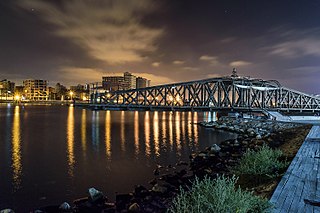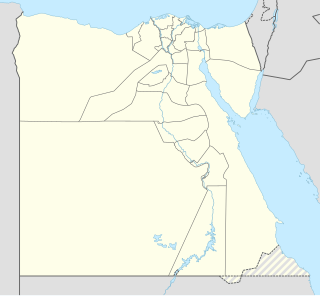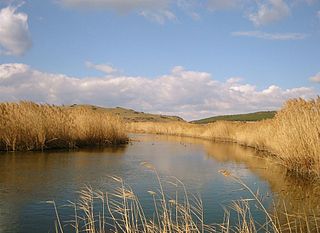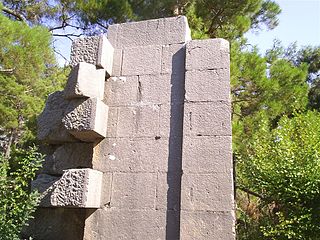Related Research Articles

Damietta is a port city and the capital of the Damietta Governorate in Egypt, a former bishopric and present multiple Catholic titular see. It is located at the Damietta branch, an eastern distributary of the Nile Delta, 15 kilometres (9.3 mi) from the Mediterranean Sea, about 200 kilometres (120 mi) north of Cairo.

Pelusium was an important city in the eastern extremes of Egypt's Nile Delta, 30 km to the southeast of the modern Port Said. It became a Roman provincial capital and Metropolitan archbishopric and remained a multiple Catholic titular see and an Eastern Orthodox active archdiocese.
Mallus was an ancient city of Cilicia Campestris lying near the mouth of the Pyramus river, in Anatolia. In ancient times, the city was situated at the mouth of the Pyramus, on a hill opposite Magarsa which served as its port. The district was called from it, Mallotis. The location of the site is currently inland a few km from the Mediterranean coast on an elevation in the Karataş Peninsula, Adana Province, Turkey, a few km from the city of Karataş.

Thmuis was a city in Lower Egypt, located on the canal east of the Nile, between its Tanitic and Mendesian branches. Its ruins are near the modern city of Timayy al-Imdid.
Trocmades or Trocmada was a city in the Roman province of Galatia Secunda. It appears to have been on the site of the modern Turkish village of Kaymaz, about twenty-four miles east of Eskişehir, Turkey.
Berissa, also spelled Berisa, Verisa, or Verissa, was a city in the late Roman province of Pontus Polemoniacus, in Asia Minor, which Kiepert and W. M. Ramsay have identified with the modern village of Baulus, 25 kilometres south-west of Tokat.
Ostracine was an ancient city in the Roman province of Augustamnica Prima. It also served as a Latin Catholic bishopric, a suffragan of Pelusium, the metropolitan see of the province.
Nyssa was a small town and bishopric in Cappadocia, Asia Minor. It is important in the history of Christianity due to being the see of the prominent 4th century bishop Gregory of Nyssa. Today, its name continues to be used as a titular see in the Eastern Orthodox Church and the Roman Catholic Church.
Augustamnica (Latin) or Augoustamnike (Greek) was a Roman province of Egypt created during the 5th century and was part of the Diocese of Oriens first and then of the Diocese of Egypt, until the Muslim conquest of Egypt in the 640s.

Myrina was one of the Aeolian cities on the western coast of Mysia, about 40 stadia to the southwest of Gryneion. The former bishopric is now a Latin Catholic titular see.
Synaus or Synaos, also spelled Synnaus or Synnaos (Σύνναος), was a city in the Roman province of Phrygia Pacatiana, now Simav, Kütahya Province, Turkey.
Basilinopolis or Basilinoupolis was a town in Bithynia Prima, which obtained the rank of a city under, or perhaps shortly before, Roman Emperor Julian the Apostate, whose mother was Basilina.
Cotenna or Kotenna was a city in the Roman province of Pamphylia I in Asia Minor. It corresponds to modern Gödene, near Konya, Turkey.
Hephæstus was a town in Roman Egypt, in the province of Augustamnica Prima, the eastern part of the Nile Delta.
Phacusa was a city in the late Roman province of Augustamnica Prima. It served as a bishopric that was a suffragan of Pelusium, the metropolitan see of that province.
Trapezopolis or Trapezoupolis (Τραπεζούπολις) was a city of ancient Caria, and later in the late Roman province of Phrygia Pacatiana Prima.

Colybrassus or Kolybrassos was a city in Cilicia Tracheia that belonged to the Roman province of Pamphylia Prima, identified as such by Ptolemy.

Etenna was a city in the late Roman province of Pamphylia Prima. Centuries earlier, it was reckoned as belonging to Pisidia, as by Polybius, who wrote that in 218 BC the people of Etenna "who live in the highlands of Pisidia above Side" provided 8000 hoplites to assist the Seleucid usurper Achaeus.
Erymna or Orymna was a town in ancient Pamphylia or Lycia. The form "Orymna" is that given in the Synecdemus and the Notitiae Episcopatuum. and in the ecumenical councils, but inscriptions found on the site show that the inhabitants used the form with "E". Stephanus of Byzantium stated that the form used in the Lyciaca of Alexander Polyhistor was Erymnae. The modern name of the site is Ormana, reflecting the ancient name.
References
- 1 2 Annuario Pontificio 2013 (Libreria Editrice Vaticana 2013 ISBN 978-88-209-9070-1), "Sedi titolari", p. 860
- 1 2 Sophrone Pétridès, "Casium" in Catholic Encyclopedia (New York 1908)